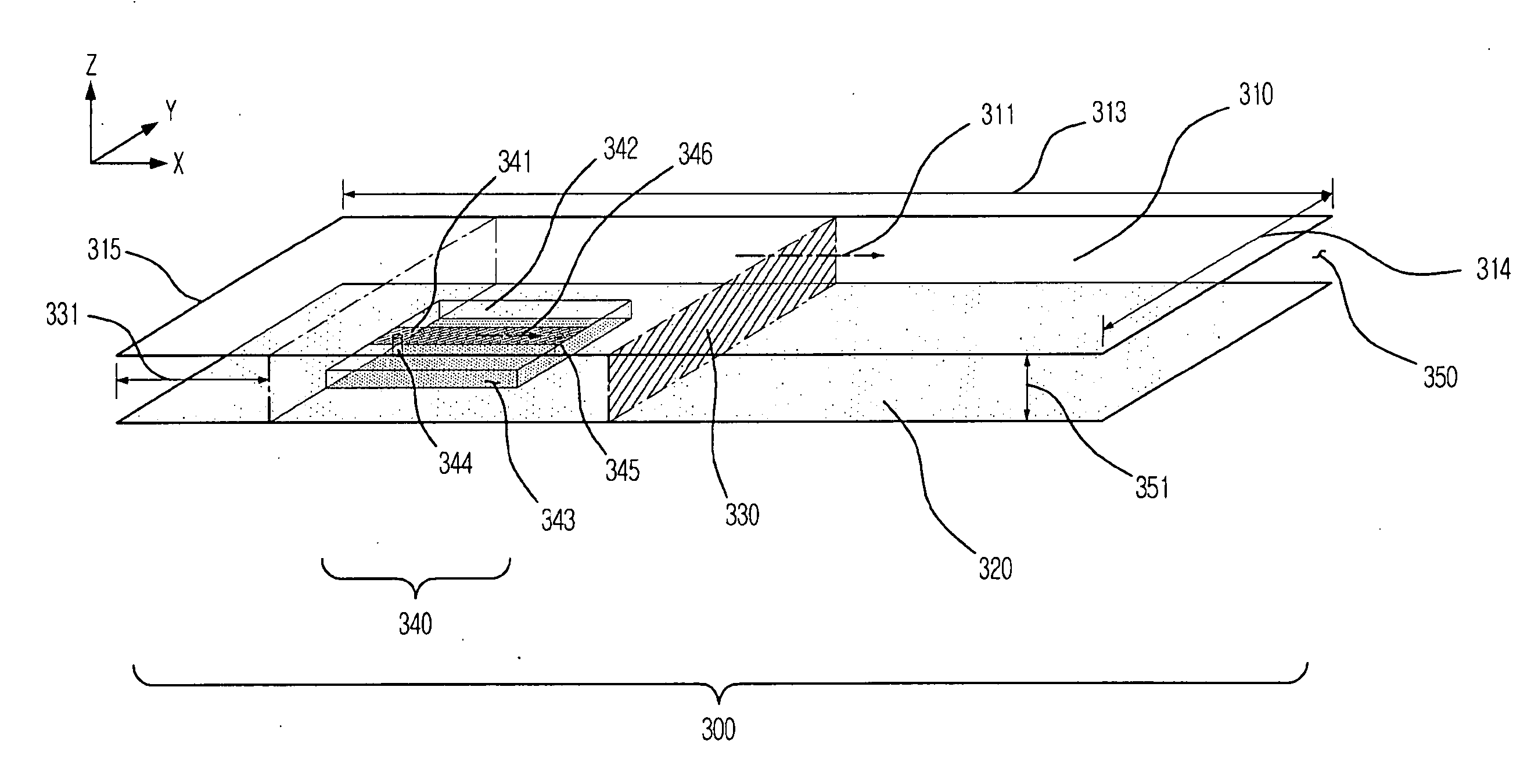Antenna Using Proximity-Coupling Between Radiation Patch and Short-Ended Feed Line, Rfid Tag Employing the Same, and Antenna Impedance Matching Method Thereof
a technology of proximity coupling and radiation patch, which is applied in the direction of resonant antennas, burglar alarm mechanical actuation, instruments, etc., can solve the problems of miniaturization and production cost of the method using the matching circuit, and the limitation of the transmission power of the rfid reader. achieve excellent performan
- Summary
- Abstract
- Description
- Claims
- Application Information
AI Technical Summary
Benefits of technology
Problems solved by technology
Method used
Image
Examples
first embodiment
[0047]FIG. 3 is a perspective view showing a tag antenna in accordance with the present invention. The tag antenna 300 includes a rectangular radiation patch 310 and a ground plate 320 disposed in parallel to the radiation patch 310. The radiation patch 310 is proximity-coupled with a microstrip feed line 341.
[0048]The feeding part 340 of the tag antenna 300 includes a dielectric substrate 342 disposed between the radiation patch 310 and the ground plate 320, the microstrip feed line 341 disposed in one side of the dielectric substrate 342, and the ground surface 343 disposed in the other side of the dielectric substrate 342. The feeding part 340 is interposed between the radiation patch 310 and the ground plate 320, and the ground surface 343 of the feeding part 340 is connected to the ground plate 320 in direct current (DC) or in alternating current (AC) through capacitive coupling. The ground surface 343 connected to the ground plate 320 in alternating current can be fabricated b...
second embodiment
[0062]FIG. 4 is a perspective view showing a tag antenna in accordance with the present invention. The tag antenna 400 of FIG. 4 reduces the length 413 of the radiation patch 410 by additionally including the shorting plate 430 between the radiation patch 410 and the ground plate 42 to connect the radiation patch 410 and the ground plate 420 with each other. The shorting plate 430 is set up perpendicularly to a resonance length direction 41 at the brim in opposite to the tag chip feed 444 in the radiation patch 410. The width 431 of the shorting plate 430 may be different from the width 414 of the radiation patch 410. In FIG. 4, the input impedance of the tag antenna 400 is controlled in the same method as in FIG. 3.
third embodiment
[0063]FIG. 5 is a perspective view showing a tag antenna in accordance with the present invention. The tag antenna 500 reduces the length 513 of the radiation patch 510 by additionally disposing shorting pins 530 between the radiation patch 510 and the ground plate 520 to connect the radiation patch 510 with the ground plate 520. The shorting pins 530 are set up perpendicularly to the resonance length direction at the brim in opposite to the tag chip feed in the radiation patch 510. The input impedance of the tag antenna 500 shown in FIG. 5 is controlled in the same method as in FIG. 3.
[0064]Also, the tag antenna 500 of FIG. 5 has a small feeding part 540 by forming the feed line 541 in a meander structure. The feed lines 341 and 441 of the tag antennas 300 and 400 illustrated in FIGS. 3 and 4 have a straight line shape. However, the feed lines 341 and 441 may be fabricated in diverse structures widely known to those skilled in the art of the present invention, which includes the me...
PUM
 Login to View More
Login to View More Abstract
Description
Claims
Application Information
 Login to View More
Login to View More - R&D
- Intellectual Property
- Life Sciences
- Materials
- Tech Scout
- Unparalleled Data Quality
- Higher Quality Content
- 60% Fewer Hallucinations
Browse by: Latest US Patents, China's latest patents, Technical Efficacy Thesaurus, Application Domain, Technology Topic, Popular Technical Reports.
© 2025 PatSnap. All rights reserved.Legal|Privacy policy|Modern Slavery Act Transparency Statement|Sitemap|About US| Contact US: help@patsnap.com



